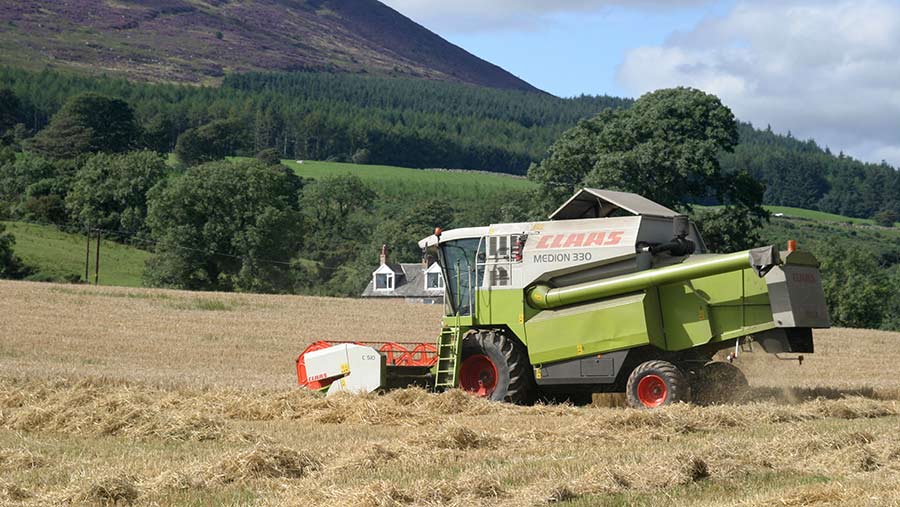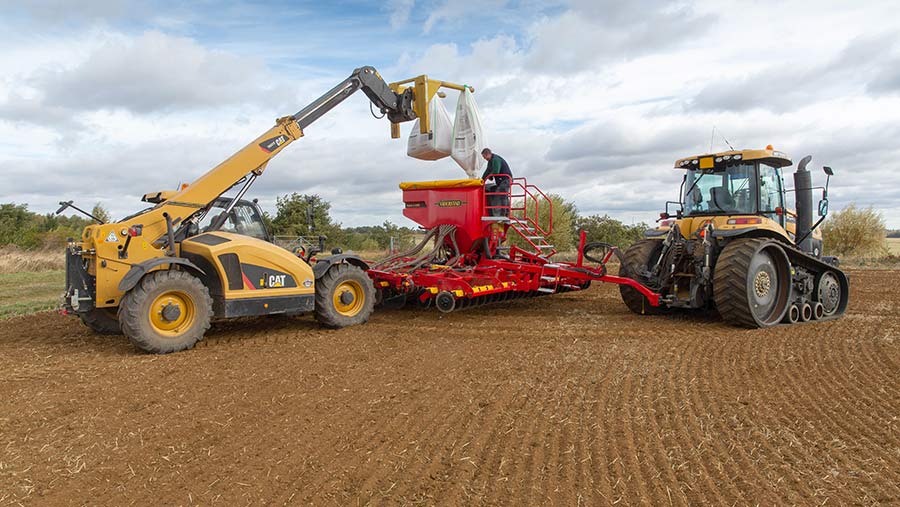Which feed wheat varieties to grow in your region
 © Topdog Images/Alamy
© Topdog Images/Alamy Group 4 feed wheats are well known as the barn-busters, delivering high yields, and the two additions to the AHDB Recommended List bring even more output.
Both Skyscraper and Spotlight top the list on yield, however, are they suited for growing in all regions of the UK?
In the north, suitability for distilling is the key factor when choosing a soft Group 4 wheat, with the Scottish Recommended List giving four varieties a “good” rating.
To help farmers with their choices this autumn, Farmers Weekly looks at the variety options for drilling.
See also: Tips on picking the right winter barley variety
East
Within the feed wheat sector, hard Group 4s generally dominate in the east, but there are two particularly good soft Group 4 options in Skyscraper and Spotlight, both offering yields that compete with hard feed wheats.
Skyscraper has the highest headline yield, and is good on most diseases. It needs “looking after” though, as its septoria score is only 5.2 and straw is quite long, although standing power is good if managed appropriately, says Clare Leaman, cereal variety specialist at crop consultant Niab.
Skyscraper has decent grain quality, is reasonably competitive and looks good in later drilled situations, adds Agrii’s national arable seed manager, Barry Barker.
“Spotlight offers slightly stiffer straw, although may not be quite as competitive on grass weeds.”
There are many good varieties within the hard Group 4 sector, although Gravity, Gleam, Kerrin and Graham are noteworthy options for the east, given good disease profiles and high yield potential.
With slightly slower development, Gravity, Gleam and Kerrin are less suited to early drilling, whereas Graham may be a better option in this situation, Mr Barker notes.
Graham has often been favoured in the west for its strong septoria resistance (6.9), but it performs well in the east too, although unlike the others it lacks orange wheat blossom midge resistance.
Costello is another hard Group 4 worth considering, Mr Barker says.
“It’s 4% behind the likes of Gravity in terms of yield, but has good yellow rust resistance, good stiffness and the best specific weight available. It’s not midge resistant and you need to watch brown rust though.”
North
The uncertain future of bioethanol production in the north-east is having little impact on wheat variety choice, with high yielding feed wheats still proving popular.
That’s not surprising given the limited number of homes for quality wheat as you head further north, says Chris Guest, head of seed at ADM Agriculture.
He highlights that the re-opening of the Ensus plant at a reduced rate of operation in March 2019 means there is regional demand for feed wheat.
“Ensus has been a well-documented stop-start affair,” he says. “High yielding feed wheat varieties have gone from being the business to carrying an element of risk, but currently they are needed again.”
Fortunately, there are also feed compounders and flour mills in Yorkshire, as well as specialist homes for biscuit wheats, he notes. “The Manchester mills are not far away either, so growers do have a choice.”
Beyond North Yorkshire, the Scottish distilling market exerts an influence and varieties need to be chosen according to the distillers’ specific requirements (see below).
Yield potential
Starting with yield potential, Mr Guest selects the new soft Group 4 Skyscraper, which is the highest yielding of all of the feed wheats on 106% and can also attract a small premium for soft wheat on a minimal specification.
“Skyscraper is an exciting addition to the Recommended List,” he says.
“It has a 2% yield advantage over the hard feed varieties and it produces bold grain. Growers shouldn’t focus too much on its soft endosperm and forget that it fits just as well as a feed wheat.”
Initial fears about its straw strength have subsided, as the variety has remained upright this year, he adds.
“It’s variety that you would want to look after for its tremendous yield potential, so a robust plant growth regulator programme should be standard practice anyway.”
Its stablemate Spotlight doesn’t do as well in the north, while other soft feed wheats either aren’t as strong on septoria or have an agronomic or market weakness.
“Revelation will still take a chunk of the market in the north, due to its disease resistance package,” he predicts. “Some of the others are looking a bit dirty now.”
Hard feed wheats
Turning to the hard Group 4s, Mr Guest’s other feed wheat choices are Gravity, Gleam and Kerrin – with Gleam being his overall preference.
“Gleam has stiffer straw than the other two, is earlier to mature and is better on septoria,” he points out.
“There have been rumours that it is more susceptible to yellow rust than its 7 rating indicates, but yellow rust is less of an issue as you go further north.”
He expects both Gravity and Kerrin to also feature on farms, but not Graham. “Graham is less suited to the north, despite its appeal in other areas.”
Costello is the other feed variety which will take some market share, due to its consistency, although it lacks the “razzle dazzle” factor of newer choices, he notes.
Varieties
East
Group 4 hard: Costello, Graham, Gravity, Gleam and Kerrin
Group 4 soft: Skyscraper and Spotlight
North
Group 4 hard: Costello, Gleam, Gravity and Kerrin
Group 4 soft: Revelation, Skyscraper and Spotlight
South
Group 4 hard: Crispin, Costello, Gravity, Graham (avoid early drilling and as second wheat) and Gleam. Shabras (as a later-drilled second wheat)
Group 4 soft: Skyscraper and Spotlight
West
Group 4 hard: Costello, Dunston, Gleam, Graham, Gravity and Shabras
Group 4 soft: Skyscraper and Spotlight
South
Farmers should consider the implications of not being able to spray for 10 days at either the T1 or the T2 fungicide timing before choosing wheat varieties for the south of the country, says agronomist Jock Willmott of Strutt and Parker.
He says consistent performance from varieties in changing environmental conditions is not a given, especially with the trend for warmer winters.
“A variety’s disease resistance ratings are a good guide,” he says. “But as we’ve seen this year, local field conditions continue to trump them.”
Rust threat
Yellow and brown rust scores have come under pressure from suspected new races in 2019, while septoria has been an ever-present threat – even in a largely dry year.
As a result, Mr Willmott believes that disease risks to any farming business should be weighed up before final decisions are made, as variety resistance will need to bridge some of the gap that will be left when the multi-site fungicide chlorothalonil goes.

© Tim Scrivener
“Going forward, fungicide spend will have to be targeted and specific,” he says. “Variety choice and drilling date will have to be used to help with the resulting challenges.”
Lee Bennett, head of seeds at Openfield points out that yellow rust is changing and has affected far more varieties this year than it should have done, meaning that some of the Recommended List ratings are already out-of-date.
Of the two new high-yielding soft Group 4s from Limagrain, Skyscraper and Spotlight, Mr Bennett picks out Skyscraper.
“There’s a market for it with Whitworths. It is a taller type, but its straw strength is fine, and it’s a good second wheat too. There’s nothing bad about it, although there are others with higher septoria ratings.”
He describes Skyscraper as a high biomass, early maturing wheat, which has shown no vulnerability to the rust diseases this year.
Spotlight is similar, but slightly later to mature and with marginally better grain quality. “However, it is one that has shown some yellow rust this year, so that will need watching.”
Moving to the hard feed wheats, he warns that yellow rust has been making its presence felt in a number of varieties, creating some uncertainty.
Starting with the varieties he believes are still unaffected by the disease, he highlights Costello, Gravity and Crispin.
“Costello is short and stiff, has grain like sugar puffs and has never taken a pustule of yellow rust. Growers should ignore the RL yield figure, as it does far better on farm.”
Crispin is a niche variety, which works well as a first wheat when it is late sown on light soils, he adds.
“Gravity, which tops the list, can be a bit of a handful,” he says.
“It is a high input, high output type, as it produces a thick, dense canopy and needs management. Don’t go wild with your seed rate and use growth regulators.
“In its favour, Gravity is a great second wheat, has blossom midge resistance and doesn’t seem to be carrying unexpected disease.”
Graham, which has always taken seedling yellow rust, seems to have struggled in 2019. “For some reason, its adult plant resistance hasn’t been as vigorous. But it has a good septoria rating of 6.9.”
His advice is not to sow Graham early, or to grow it as a second wheat.
Gleam, with a yield of 104% and good disease resistance scores, is a variety which works well with Gravity, he suggests.
“It has good grain quality and is early to harvest. However, it’s unlikely to be a 7 for yellow rust by next year – it’s another variety which is showing unexpected levels of the disease.”
Shabras, also from Syngenta, needs a good plant growth regulator programme, he advises. “Drill it later and grow it as a second wheat.”

© Tim Scrivener
West
Winter wheat varieties with good disease resistance are set to take a greater share of the acreage in the west of the country as fungicide options continue to decline, seed merchants and agronomists predict.
Ahead of the new growing season, growers are being advised to look for varieties with a minimum rating of 6 for septoria, as the typically wetter climate in the region is more conducive to the disease’s development.
As Chris Bean, Zantra’s technical director explains, although both yellow and brown rust have been creating surprises and grabbing the headlines this year, there will be more chemistry remaining for rust control than for septoria.
That makes it important for growers to make the most of genetic diversity, he stresses.
“With all the changes that are taking place, it’s never been so important to keep a close eye on disease resistance ratings and to investigate how varieties are performing in your area. Local growing conditions can have a great deal of influence on their results.”
Hard Group 4 varieties with the required minimum septoria rating of 6 include Gleam, Shabras, Graham, Dunston and Costello. Within that group, however, there is concern about susceptibility to a new yellow rust race – especially where varieties have Hereford in their parentage.
“That includes Dunston, Shabras and Gleam,” says Nick Green, of seed merchant T Denne and Sons. “They may not be as clean as we thought, but we do have to tools to deal with yellow rust.”
Graham has done particularly well in the west region and remains popular, but has been losing green leaf area to disease this year, reports Chris Bean.
“There are lesions on the leaf, but they don’t seem to be septoria. One possibility is that they are a reaction to the yellow rust it carries at the seedling stage.”
Costello continues to tick all the boxes and is one of the most consistent varieties on the Recommended List, continues Nick Green
“It has very good grain quality, strong disease resistance and stiff straw. It’s a very good example of why yield shouldn’t always be the main consideration.”
Gravity, despite its lower septoria score, also deserves a mention, he ends. “It’s a very good second wheat, can be grown across all sites and has a wide drilling window. It is carrying more disease now, but it can be managed.”

